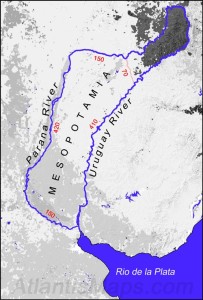Grahan Hancock
Palambo, Francesco
 Francesco Palambo has published a few short Atlantis-related articles on his website(a). Obviously influenced by the theories of Constantino Cattoi and Evelino Leonardi, he has suggested that Atlantis had existed off the coast of Tuscany opposite the peninsula of Argentario. This would place it in the territory of sunken Tirrenide.
Francesco Palambo has published a few short Atlantis-related articles on his website(a). Obviously influenced by the theories of Constantino Cattoi and Evelino Leonardi, he has suggested that Atlantis had existed off the coast of Tuscany opposite the peninsula of Argentario. This would place it in the territory of sunken Tirrenide.
His own theories echoing Graham Hancock include the idea that there existed pre-Flood “advanced civilisations (with scientific and technological knowledge even higher than ours)”!
(a) Atlantide vicino all’Argentario? – Pagine Curiose (Italian)
Fisher, Doug
 Doug Fisher is the author of a long-awaited book with the intended title of The Atlantis Maps: The Rise of Atlantis and the Fall of a Paradigm in which he identifies Atlantis as North and South America with the Plain described by Plato being the region of Mesopotamia, in northeast Argentina. The book was eventually published in 2018 as Maps, Myths and Paradigms [1924] with details of its contents listed on his website.(c) Four chapters had been available online(a) together with a few additional articles.
Doug Fisher is the author of a long-awaited book with the intended title of The Atlantis Maps: The Rise of Atlantis and the Fall of a Paradigm in which he identifies Atlantis as North and South America with the Plain described by Plato being the region of Mesopotamia, in northeast Argentina. The book was eventually published in 2018 as Maps, Myths and Paradigms [1924] with details of its contents listed on his website.(c) Four chapters had been available online(a) together with a few additional articles.
Fisher has published an illustrated paper on Graham Hancock’s website with the self-explanatory title of The Walls of Atlantis(b). His suggestion of a huge outer wall encircling the city of Atlantis has been disputed by Jim Allen, provoking further comments(c) from Fisher.
He has also criticised the methodology, which Allen used to place Atlantis on the Altiplano(d), while I question the credibility of both their theories.
When Fisher’s book was finished and due for publication with its new title, he closed his old website and prepared a new site(e) to coincide with the publication of the book.
Fisher has published two other papers(f) on Hancock’s website relating to the maps of Johannes Schöner and Oronteus Finaeus.>In October 2022 he published another paper on the same site challenging the currently accepted theory of plate tectonics highlighting weaknesses in the concept and proposing a fresh look at the expanding earth hypothesis.<
(a) See: Archive 2865 (no images)
(b) https://grahamhancock.com/fisherd3/
(c) http://www.abovetopsecret.com/forum/thread646457/pg2 (halfway down the page)
(d) http://www.abovetopsecret.com/forum/thread821281/pg1
(e) http://www.copheetheory.com/
(f) https://grahamhancock.com/author/doug-fisher/
(g) Maps, Myths & Paradigms – Graham Hancock Official Website *
Finaeus, Oronteus
Oronteus Finaeus (1494-1555) was a celebrated cartographer who produced a map in 1531 which is claimed by some that, like the Piri Reis  Map, it depicts the coast of an ice-free Antarctica. Charles Hapgood rediscovered it in 1959(a) in the Library of Congress. This idea is then used to support the concept of the existence of a very early civilisation that was capable of sophisticated map-making. It is then just a short step to name this civilisation ‘Atlantis’. Some, such as the Flem-Aths went further and actually nominated Antarctica as the home of Atlantis.
Map, it depicts the coast of an ice-free Antarctica. Charles Hapgood rediscovered it in 1959(a) in the Library of Congress. This idea is then used to support the concept of the existence of a very early civilisation that was capable of sophisticated map-making. It is then just a short step to name this civilisation ‘Atlantis’. Some, such as the Flem-Aths went further and actually nominated Antarctica as the home of Atlantis.
Robert Argod has used the Oronteus Finaeus Map to support his contention that the Polynesians had originated in Antarctica.
>Christine Pellech has an article published on the Atlantisforschung website taken from her 2013 book Die Entdeckung von Amerika [1188] (The Discovery of America), in which she reviews the range of medieval maps displaying geographical details ‘unknown’ until centuries later!(e) Her reference to the Mark McMenamin coins can be ignored as they have since been shown to be forgeries (See: Sardinia).<
However, a contrary view has been expressed by Paul Heinrich who commenting on Graham Hancock’s assertion that the map shows an ice-free Antarctica, points out that in the case of West Antarctica, the underlying bedrock is, in the main, hundreds of feet below sea level and would not show on a real map of the region(c).
A more recent website(b), although not endorsing an Antarctic Atlantis, discusses some of these old maps in very great detail and on Graham Hancock’s website. The site is based on a number of chapters from a work-in-progress, The Atlantis Maps: The Rise of Atlantis and the Fall of a Paradigm by Doug Fisher. He identifies the Plain of Mesopotamia in Northern Argentina as the location of Atlantis.
(a) https://archive.aramcoworld.com/issue/198001/piri.reis.and.the.hapgood.hypotheses.htm
(b) https://web.archive.org/web/20180831132132/https://www.atlantismaps.com/ ^30.10.2020 “This URL has been excluded from the Wayback Machine.”
(c) https://atlantipedia.ie/samples/archive-3967/
Appleby, Nigel
Nigel Appleby (a.k.a. Major Niall Arden) is the ‘author’ of Hall of the Gods[076], which purported to identify the location, in Egypt, of the Hall of Records that is supposed to contain the accumulated knowledge of an advanced worldwide civilisation that preceded the ancient Egyptians.
The author wrote of ‘Atlantis’ being “really just a symbolic name for the previous worldwide civilisation that existed prior to the last reversal of the Sun and Earth’s magnetic fields and the subsequent cataclysm that followed.” He then added that most of this civilisation still exists, virtually intact, beneath the Antarctic ice (p.363). He also claimed to have identified Nibiru in Sumerian texts independently of Zechariah Sitchin and to have deduced that it is “about the size of Earth and nearer than anticipated.”
He also announced the establishment of ‘Operation Hermes’, which had the objective of locating the Hall of Records near Giza(c) as well as other expeditions to Central & South America, China and Antarctica (p.378). Operation Hermes was abandoned when the Egyptian authorities refused permission for the expedition.
Shortly after the publication of the book in 1998, the publishers had to withdraw it from sale following claims of plagiarism by a number of other authors(a). Lynn Picknett & Clive Prince reveal some of the details of this episode in their Stargate Conspiracy [705.97].>Ian Lawton & Chris Ogilvie-Herald also devote a chapter of Giza the Truth [1690] to ‘The Appley Affair’ giving more detail, particularly the battle that Ralph Ellis had to demonstrate that large chunks of his book, Thoth: Architect of the Universe, had been used by Appleby.<
The whole matter was further confused when Graham Hancock and Robert Bauval along with Colin Wilson, Andrew Collins, Christopher Knight, Robert Lomas, Simon Cox and Alan Alford issued An Official Statement Regarding Operation Hermes(a) declaring that they were unaffiliated with Operation Hermes, then and in the future.
Lightning struck twice when the second book of Appleby’s, Desert Fire, was also withdrawn from sale within days of publication in 2006!
(a) https://www.mail-archive.com/ctrl@listserv.aol.com/msg03919.html
(b) https://www.dailygrail.com/blogs/Chris-Ogilvie-Herald/2006/7/Nigel-Appleby-Egypt-Iraq
(c) https://web.archive.org/web/20010818232620/http://www.islandearth.net/hermes/content.htm
